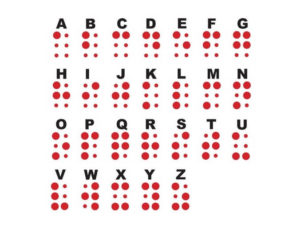We Must Continue to Invest in Braille
BY GREGORY J. DONNELLY (VIA COMMONWEALTH MAGAZINE)
 Only 1 in 5 visually impaired school children read using Braille.
Only 1 in 5 visually impaired school children read using Braille.
IN A WORLD where technology is rapidly opening new doors for people with vision loss, most notably in the case of the smartphone and its applications that greatly aid navigation, shopping, and other activities, one might think that braille is going the way of the buggy whip. The reality, as seen every day on our campus, the Carroll Center for the Blind, is that this tactile tool for people who cannot see is vitally important to learning and living in today’s world, and we are not doing enough to ensure that braille can thrive.
As we observe National Braille Literacy Month, we must contemplate the importance of braille and consider how we can sustain and strengthen it. Braille dates to the 19th century, when it was developed by the French educator Louis Braille. Reading braille – a code based on cells of up to six dots that can be read with the fingers – is akin to when a sighted person reads text. Think about how you learned math, chemistry, or a piano composition. Would your learning have been effective if someone read those formulas or the array of musical notes to you?
For those with vision impairment, being able to read letter by letter, symbol by symbol, number by number, is critical to the learning process. While technology – particularly in the form of computers, tablets, and smartphones – is making adapting to the sighted world easier for those who are blind, there is no substitute for having a tactile communications system.
Yet, despite the importance of braille, our schools across Massachusetts and the nation are faced with a significant shortage of teachers of the visually impaired and vision rehabilitation therapists. Currently, according to the National Braille Press, only 1 in 5 school children use braille, which partly results from the lack of available educators.
At the same time, for school districts facing overwhelming costs and limited revenue – particularly in Massachusetts’s Gateway Cities where school budgets are very constrained and are now the subject of a lawsuit that is being brought against the state – education for visually impaired students can take a back seat to the need to provide an adequate education for all students.
We must continue to invest in braille and teaching it. Each year, the Carroll Center hosts the Northeast Regional Braille Challenge, an event developed by the Braille Institute to motivate students to practice and hone their braille literacy skills. According to the American Printing House for the Blind, there are more than 60,000 legally blind students in the US; only about 5,000 read braille, and only around 1,000 participate in the annual challenge.
With unemployment a key concern among those with vision loss, braille often bridges the gap and enables individuals to work effectively and successfully in all kinds of professions. Of the roughly one-quarter of blind people who are employed, the majority of them are braille readers, according to the National Braille Press.
As technology evolves to continue to serve more people with vision loss, we must ensure that braille remains a component of new computer programs and applications. For example, there are efforts underway to fully adapt braille to electronic platforms, but there are barriers. Companies that can make these products are stymied by a relatively small market, and thus the cost of things like braille e-books is significantly more than purchasing a Kindle or Nook e-reader device.
We are approaching a world of amazing possibilities for people with vision loss. We must continue to invest in literacy by supporting and nurturing braille. It is nearly two centuries old, but has never been more relevant today.
Read the story “We must continue to invest in braille” at article source here.


